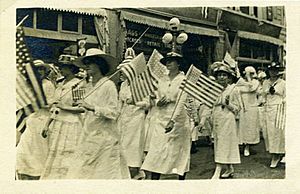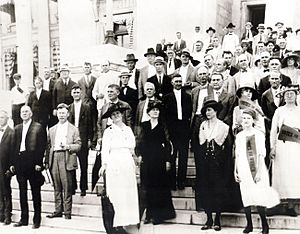Timeline of women's suffrage in Arkansas facts for kids
This article shares the story of how women in Arkansas gained the right to vote. This important movement is called women's suffrage. Early efforts to give women the vote started way back in 1868. That's when Miles Ledford Langley tried to add a women's voting law to the state's main rulebook.
The very first group for women's voting rights in Arkansas was formed in 1881 by Lizzie Dorman Fyler. Another group started in 1888, led by Clara McDiarmid. The work for women's suffrage continued steadily, even if it was slow at times, until the 1910s. Then, new groups formed and worked hard for laws that would let women vote. In 1917, women in Arkansas won the right to vote in state primary elections. These are elections where parties choose their candidates.
In May 1918, a huge number of women, between 40,000 and 50,000, voted for the first time in Arkansas's primary elections. This was a big step! On July 28, 1919, Arkansas officially approved the Nineteenth Amendment to the U.S. Constitution. This amendment gave women across the entire country the right to vote. Finally, on December 3, 1919, the League of Women Voters (LWV) of Arkansas was created to help new women voters.
Contents
The 1800s: Early Steps for Women's Vote
1860s: First Ideas for Suffrage
1868
- Miles Ledford Langley from Arkadelphia, Arkansas suggested a law for women's voting rights. He did this at a special meeting to write the state's constitution.
1869
- The Arkansas Gazette newspaper started printing articles about women's rights.
1870s: Voices for Change
1870
- January 5: Phoebe Couzins, a speaker for women's rights, gave a speech in Little Rock, Arkansas.
1880s: Groups Begin to Form
1881
- September 10: The Arkansas Woman Suffrage Association (AWSA) was created. Lizzie Dorman Fyler was its first president.
1885
- The AWSA group stopped meeting before October 9.
1888
- The Arkansas Equal Suffrage Association (AESA) was started by Clara McDiarmid.
1889
- Famous women's rights leader Susan B. Anthony visited Arkansas. She spoke in Helena, Fort Smith, and Little Rock.
- A newspaper focused on voting rights, called the Woman's Chronicle, began publishing.
1890s: More Action and Challenges
1890
- The Prohibition Party of Arkansas, a political group, said they supported women's right to vote.
- The first parade for women's suffrage was held in Little Rock.
1891
- Senator E.P. Hill introduced a bill in the Arkansas Senate to let white women vote.
- The Arkansas government passed a law that made voters take a type of reading test.
1893
- The Arkansas Senate passed a bill to let women vote in school board elections. But this bill did not pass in the House of Representatives.
- Arkansas started a poll tax. This meant people had to pay a fee to vote.
- The Woman's Chronicle newspaper stopped being published.
1895
- Lide Meriwether traveled around Arkansas, giving speeches about women's suffrage.
1899
- Senator Turner Butler introduced a bill to let women vote in school board elections and on "moral issues." It failed to pass.
The 1900s: The Fight Continues
1900s: New Century, New Efforts
1903
- The Socialist Party of Arkansas held its first state meeting in Little Rock. They supported equal rights for women.
1906
- African Americans were not allowed to vote in primary elections in Arkansas.
1910s: Big Steps Forward
1911
- January: A unique bill about women's suffrage was suggested in the state House of Representatives.
- March: Supporters of women's voting rights spoke at a committee meeting.
1913
- The Women's Political Equality League (PEL) started holding meetings at the City Hall in Little Rock.
1914
- PEL began a class to study current events and practice public speaking.
- October: Another State Woman Suffrage Association was formed. It was also known as the Arkansas Woman Suffrage Association (AWSA).
1915
- AWSA and PEL gave money to help the Congressional Union for Woman Suffrage. This group worked for a national amendment to let women vote.
- PEL worked with the Arkansas Federation of Women's Clubs (AFWC) to support a women's suffrage resolution.
- The Washington County Women's Suffrage Association was organized.
- October: A state meeting for voting rights was held in Little Rock.
1916
- Alice Paul came to Little Rock to start a local group of the National Woman's Party (NWP).
- April: Carrie Chapman Catt, another important suffrage leader, campaigned in Arkansas.
- October: The state suffrage meeting was held in Pine Bluff.
1917
- February: Women in Arkansas gained the right to vote in primary elections. This was a major victory!
- The suffragists in the State Suffrage group reorganized. They became the Equal Suffrage State Central Committee (ESSCC).
- Freda Hogan Ameringer helped women in Huntington, Arkansas pay their poll taxes. This made sure they could vote when the time came.
- Mabel Vernon campaigned in Arkansas for the NWP.
1918
- April 2: The ESSCC held its first yearly meeting.
- April 3: Anna Howard Shaw, a famous speaker, gave a speech in Arkansas.
- May: Between 40,000 and 50,000 women voted in the primary election. This showed how many women wanted to use their new right.
- July: A state meeting was held to discuss changes to the state constitution. Full women's suffrage was considered, but it wasn't added to the final plan.
- July 10: Women delegates attended the State Democratic convention. A statement supporting women's suffrage was officially adopted.
1919
- July 28: Arkansas officially approved the Nineteenth Amendment to the U.S. Constitution. This amendment gave women the right to vote across the country.
- December 3: The ESSCC group changed its name and became the League of Women Voters (LWV) of Arkansas. This new group helped women learn about voting and politics.




